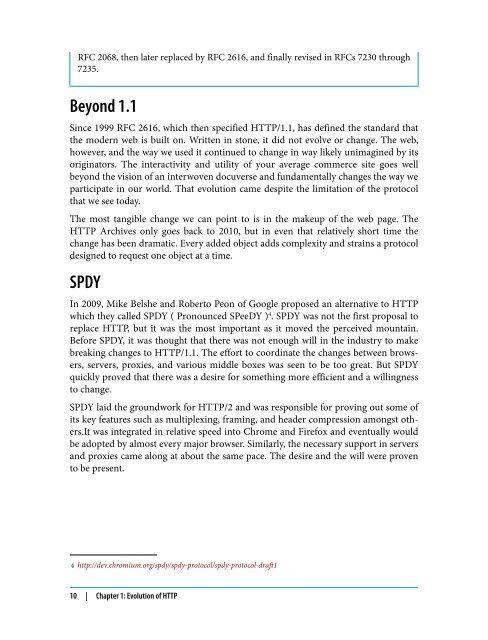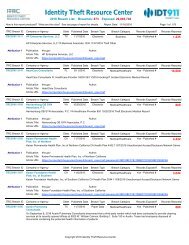You also want an ePaper? Increase the reach of your titles
YUMPU automatically turns print PDFs into web optimized ePapers that Google loves.
RFC 2068, then later replaced by RFC 2616, and finally revised in RFCs 7230 through<br />
7235.<br />
Beyond 1.1<br />
Since 1999 RFC 2616, which then specified <strong>HTTP</strong>/1.1, has defined the standard that<br />
the modern web is built on. Written in stone, it did not evolve or change. The web,<br />
however, and the way we used it continued to change in way likely unimagined by its<br />
originators. The interactivity and utility of your average commerce site goes well<br />
beyond the vision of an interwoven docuverse and fundamentally changes the way we<br />
participate in our world. That evolution came despite the limitation of the protocol<br />
that we see today.<br />
The most tangible change we can point to is in the makeup of the web page. The<br />
<strong>HTTP</strong> Archives only goes back to 2010, but in even that relatively short time the<br />
change has been dramatic. Every added object adds complexity and strains a protocol<br />
designed to request one object at a time.<br />
SPDY<br />
In 2009, Mike Belshe and Roberto Peon of Google proposed an alternative to <strong>HTTP</strong><br />
which they called SPDY ( Pronounced SPeeDY ) 4 . SPDY was not the first proposal to<br />
replace <strong>HTTP</strong>, but it was the most important as it moved the perceived mountain.<br />
Before SPDY, it was thought that there was not enough will in the industry to make<br />
breaking changes to <strong>HTTP</strong>/1.1. The effort to coordinate the changes between browsers,<br />
servers, proxies, and various middle boxes was seen to be too great. But SPDY<br />
quickly proved that there was a desire for something more efficient and a willingness<br />
to change.<br />
SPDY laid the groundwork for <strong>HTTP</strong>/2 and was responsible for proving out some of<br />
its key features such as multiplexing, framing, and header compression amongst others.It<br />
was integrated in relative speed into Chrome and Firefox and eventually would<br />
be adopted by almost every major browser. Similarly, the necessary support in servers<br />
and proxies came along at about the same pace. The desire and the will were proven<br />
to be present.<br />
4 http://dev.chromium.org/spdy/spdy-protocol/spdy-protocol-draft1<br />
10 | Chapter 1: Evolution of <strong>HTTP</strong>





